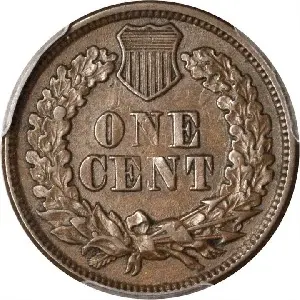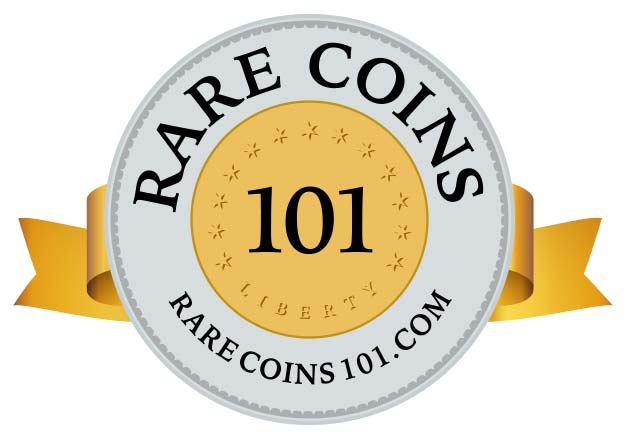1877 Indian Head Cent
For more than 100 years, the 1877 Indian Head cent has been the most sought after entry in the popular cent series of 1859-1909. Its reported mintage of 852,000 is the second lowest in the series. Only the 1909-S Indian cent has a smaller mintage, with an output of 309,000.(1)
The low mintage of the 1877 is a conspicuous anomaly. From 1859 to 1876, annual production of the Indian Head cent ranged from about 4 million to 50 million. In 1878, mintage jumped to 5.8 million, the beginning of a steep rise in cent coinage.(2)
What happened in 1877? Well, the need for cent production got hit that year with a “double whammy” to curb mintage.
The first “whammy” can be traced back to the Mint Act of 1864. Among other things, this law authorized the issuance of bronze cents, having an intrinsic metal value below its face value. The legal tender status of the new cent was limited to ten cents, meaning anyone could refuse to accept them in sums above that.(3)
After the Civil War ended in 1865, the national economy began to slowly normalize. Coins that were hoarded as a “safe harbor” during those uncertain times began to emerge from hiding, joining millions of new coins emanating from the Mint.
Because acceptance of the bronze cents and other base-metal minor coins (i.e., composed of non-precious metals) was mandatory for only minimal transactions, the supply of small denomination coins glutted the channels of commerce by 1870. Banks in particular got stuck with them, unable to move them out in volume.
The Mint Act of 1871 required the Mint to redeem minor coins from the public when received in quantities of $20 or more. The redeemed coins were melted down and made into new coins. Base-metal coinage of all kinds (copper, copper-nickel, and bronze) was covered by this legislation.
With the Mint acting as a clearinghouse, banks were able to unclog their vaults, while making small change available to anyone who needed it.
By 1874, as less of the older half cents, large cents, and copper-nickel cents were being redeemed, the Mint’s policy was amended to allow for undamaged coins turned in to be sent out together with freshly struck coins.
By the time 1877 arrived, the Mint already held millions of redeemed coins ready for release upon request. Consequently, there was a drastic cutback in cent production, with the three cent and five cent coins altogether eliminated (other than proofs).
The second “whammy” to dampen the mood for striking new 1877 cents was the on-going economic depression that started four years earlier with the “Panic of 1873.” Wages were down and unemployment soared to 20%. Not only did this stifle economic activity, many people were forced to empty their “piggy banks” to put food on the table.(4)
Many of these coins found their way back to the Mint. In 1877, an extraordinarily high number of bronze cents were redeemed, tallying over 9.9 million pieces. At the same time, 9.8 million were reissued, indicating a lesser obligation to augment the cent supply by freshly struck coinage.(5)
Fascinating Fact: Numismatic experts contend the stated 852,000 mintage of 1877 Indian cents is vastly overstated. The entire population of non-proof 1877 cents was struck with a single reverse die. Yet, the average working die from that period usually maxed out at 200,000 pieces. It seems impossible just one die could have survived long enough to strike nearly one million coins. When this information is juxtaposed with the fact there is no evidence of serious die wear only reinforces the belief the mintage of the 1877 Indian cent if much less than what was officially recorded.(6)
| Estimated survivors in all grades: 5750 ?
The survivor estimate from PCGS represents an average of one or more experts' opinions as to how many examples survive of a particular coin in all grades. Survival estimates include coins that are raw, certified by PCGS, and certified by other grading services. Learn more at PCGS. |
| PCGS Rarity Scale: 3.8 ?
The 'PCGS CoinFacts Rarity Scale' assesses the relative rarity of all U.S. coins, based on estimated surviving examples. The scale runs from 1.0 to 10.0. The higher the number, the rarer the coin.
Learn more at PCGS. |
| Search for the 1877 Indian Head Cent on eBay** |
Preview of eBay selection:
 |
 |
| Trendline Avg = 4.74 | CLASSIC RARITY |
 |
 |
| Trendline Avg = 4.74 | CLASSIC RARITY |
Historic Value Trend Charts:
| Last updated 11-9-25 | Return to Key Date Coin List | |
| Compare to Common Date Coin of Same Type | ||
|
|
||
| Download Charts to Your Computer | ||
Sources
1. PCGS. 1877 1C, BN (Regular Strike).
2. Yeoman, R.S. and Garrett, Jeff, et al. A Guide Book of United States Coins, 75th ed. Pelham, AL: Whitman Publishing, 2021.
3. Heritage Auctions. 1877 1C.
4. Burdette, Roger. Longacre's Ledger. Fly-in Club. Volume 27.2, Issue #100. Aug 2, 2017.
5. Stack's Bowers Galleries. 1877 Indian Cent. Aug 2021 Auction.
6. Heritage Auctions. 1877 1C.
**Many very fine coin dealers sell on eBay. At any point in time, there may be over one million search results for United States coins. This includes quite a few of the recommendations on our Key Date Coin List.
If you’re thinking about purchasing a rare coin, eBay is certainly worth a look. For your convenience, the links from this site to eBay are coded to bring up only coins certified by PCGS and NGC.
As is always, always the case, never buy a valuable coin from a seller whose trustworthiness cannot be verified. Learn more about this at our chapter Best Places to Buy Coins, which also has a section on doing business on eBay.
In the interest of full disclosure, Rare Coins 101 receives a small commission anytime someone connects to eBay from this site and purchases something.
Coin images by Stack's Bowers Galleries.


